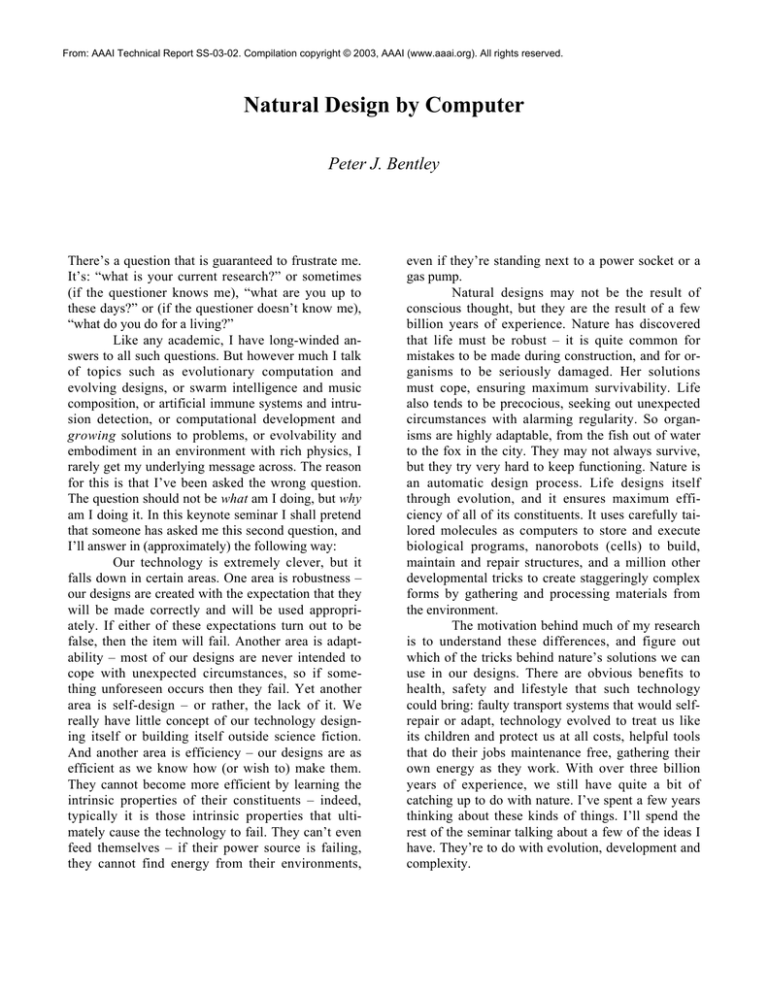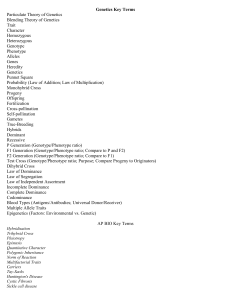
From: AAAI Technical Report SS-03-02. Compilation copyright © 2003, AAAI (www.aaai.org). All rights reserved.
Natural Design by Computer
Peter J. Bentley
There’s a question that is guaranteed to frustrate me.
It’s: “what is your current research?” or sometimes
(if the questioner knows me), “what are you up to
these days?” or (if the questioner doesn’t know me),
“what do you do for a living?”
Like any academic, I have long-winded answers to all such questions. But however much I talk
of topics such as evolutionary computation and
evolving designs, or swarm intelligence and music
composition, or artificial immune systems and intrusion detection, or computational development and
growing solutions to problems, or evolvability and
embodiment in an environment with rich physics, I
rarely get my underlying message across. The reason
for this is that I’ve been asked the wrong question.
The question should not be what am I doing, but why
am I doing it. In this keynote seminar I shall pretend
that someone has asked me this second question, and
I’ll answer in (approximately) the following way:
Our technology is extremely clever, but it
falls down in certain areas. One area is robustness –
our designs are created with the expectation that they
will be made correctly and will be used appropriately. If either of these expectations turn out to be
false, then the item will fail. Another area is adaptability – most of our designs are never intended to
cope with unexpected circumstances, so if something unforeseen occurs then they fail. Yet another
area is self-design – or rather, the lack of it. We
really have little concept of our technology designing itself or building itself outside science fiction.
And another area is efficiency – our designs are as
efficient as we know how (or wish to) make them.
They cannot become more efficient by learning the
intrinsic properties of their constituents – indeed,
typically it is those intrinsic properties that ultimately cause the technology to fail. They can’t even
feed themselves – if their power source is failing,
they cannot find energy from their environments,
even if they’re standing next to a power socket or a
gas pump.
Natural designs may not be the result of
conscious thought, but they are the result of a few
billion years of experience. Nature has discovered
that life must be robust – it is quite common for
mistakes to be made during construction, and for organisms to be seriously damaged. Her solutions
must cope, ensuring maximum survivability. Life
also tends to be precocious, seeking out unexpected
circumstances with alarming regularity. So organisms are highly adaptable, from the fish out of water
to the fox in the city. They may not always survive,
but they try very hard to keep functioning. Nature is
an automatic design process. Life designs itself
through evolution, and it ensures maximum efficiency of all of its constituents. It uses carefully tailored molecules as computers to store and execute
biological programs, nanorobots (cells) to build,
maintain and repair structures, and a million other
developmental tricks to create staggeringly complex
forms by gathering and processing materials from
the environment.
The motivation behind much of my research
is to understand these differences, and figure out
which of the tricks behind nature’s solutions we can
use in our designs. There are obvious benefits to
health, safety and lifestyle that such technology
could bring: faulty transport systems that would selfrepair or adapt, technology evolved to treat us like
its children and protect us at all costs, helpful tools
that do their jobs maintenance free, gathering their
own energy as they work. With over three billion
years of experience, we still have quite a bit of
catching up to do with nature. I’ve spent a few years
thinking about these kinds of things. I’ll spend the
rest of the seminar talking about a few of the ideas I
have. They’re to do with evolution, development and
complexity.
Let’s start with evolution. The field of evolutionary computation has shown that we can use
evolution in our computers to solve problems. With
the right kind of representations, we can optimise
existing solutions or even permit the evolution of
novelty from scratch. We also know a little about the
“character” of evolution. It’s a very forgiving technique, able to find solutions to a wide range of nasty
problems. Unlike some algorithms, an evolutionary
algorithm can usually cope with vast search spaces,
noisy objective functions, and even errors and bugs
in its own implementation. It also has some nice
properties of fault-tolerance (given a sufficiently
flexible genetic representation and operators). Researchers such as Adrian Thompson (and some of
my more recent work on gene regulatory networks)
have shown that evolution has a natural tendency
towards producing solutions that try to keep working
even after damage. The reason is the mechanism of
evolution itself. Because evolution finds solutions
through random mutations and crossovers, once it
has found a “perfect” solution, all it can do is damage that solution in subsequent generations. By
forcing evolution to continue “beyond perfection,”
(open-ended evolution is helpful here) it is forced to
protect that solution from itself, and make it tolerant
of faults (which may also mean making it more efficient as well).
But the news is not all good. It turns out to
be quite difficult to find the right kinds of genetic
representations for evolutionary algorithms. If you
get it wrong, then evolution will struggle to evolve
anything at all. Even if you get it right, there is still a
major problem of scalability. Evolve a simple genotype and you’ll end up with a simple phenotype. To
get a really complex phenotype, the corresponding
genotype may need to be so complex that evolution
can never find it. The answer to this problem seems
to be development.
Development (or embryology, or ontogenesis) is essentially a non-linear mapping process from
genotype to phenotype. It treats the genes as instructions on how the phenotype should be constructed
(instead of a direct plan of the phenotype). When the
instructions are carried out, the result is a complex
phenotype from a simpler genotype. The danger with
this kind of mapping process is: first, that it will often degrade evolvability, making it even harder to
evolve anything, and second, that the very process of
creating the developmental processes adds so much
knowledge to the system that (critics would argue)
you’ve practically solved the problem yourself.
What is needed is a developmental processes that is
both evolvable and that does not actively add any
new knowledge into the system. Instead of knowledge, capabilities must be added. And one of the
crucial capabilities is an ability for evolution to learn
and incorporate its own knowledge into the developmental process. For example, if the solution requires the creation of a module and the reuse (and
possibly modification) of the module, then the evolutionary developmental system needs to be able to
“discover the idea” of modules and their reuse and
modification for itself. If we add knowledge into the
system, by modifying representations to include
modules and their use, then we are partially solving
the problem. If the ultimate intention is to have systems able to design, maintain, and repair themselves
and so on, we must be looking at methods of enhancing capabilities but reducing problem-specific
knowledge. If it can’t even work out the idea of a
module for itself, then it doesn’t have a hope of discovering more complex ideas.
Finally (and this is a newer subject for me),
ideas of embodiment seem to be becoming more important. All natural solutions are strongly embodied
in their environments: they have many perturbatory
channels through which they affect and are affected
by their surroundings. This leads to structural coupling where, over the course of evolution, the structures of organisms are designed to fit together, the
design of each being intimately linked. So one reason why life evolved to reach the complexity and efficiency that it has, is because every organism is embodied within a rich and complex environment. In
our computers, most of our evolving solutions are in
paltry environments, if you can even call a fitness
function an environment. In the few examples where
more complex environments are introduced
(Thompson’s evolvable hardware, Sims’s virtual
creatures), we do see a significant increase in complexity and novelty from evolution.
This article is just an outline of the more
detailed presentation I shall give. But, to summarise,
I (currently) believe that, in our quest for better
technology, we need to consider evolution, development, and embodiment within a rich environment.
That’s why I’m doing my current research. You’ll
have to ask me exactly what I’m doing afterwards.








